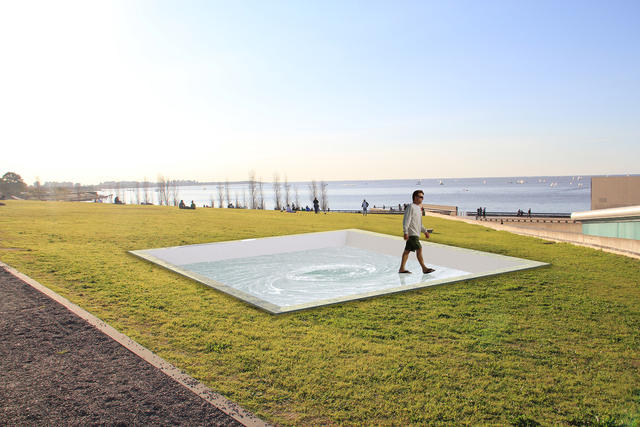Park of Memories 1999
-

-

-

-

-

Operation:
The inverted pyramid is filled with water by submergible pumps located in the tank under the pyramid (not visible). The filling process takes eight minutes. Once the preset level is reached, the water is discharged in an abrupt, violent way in one minute, laying bare a large gash at the base. Since the cycle is uninterrupted both day and night (it is fitted with relevant lighting) and the glass floor can be walked on, the observer is able to watch the whole process as it takes very little time.
Without the monumental illusion
before the eyes of the living, history
would be a mere abstraction […]
NO-PLACE
Marc Auge
The monument with its overbearing physical presence–space and matter–seems to require no words. But the word naming it leaves it bare, leaves us bare as its hidden contents are revealed in their etymological meanings.
Monument: from the Latin monēre: to remind, to notify, to inform. It is strangely related to the word ‘monster’ as it shares a common root. Among us the monsters of blind violence devastated a period of Argentine history that today calls for its monument to comply precisely with the mandate hidden in its etymological meaning: to notify, to remind, and to cause to reflect.
The work I propose is placed in the land washed by the river waters, and the gleam of the glass covering it is the only sign the walker is given.
Open to the subtle interplay of looking-self looking, of discovery- self discovery, it is sustained on “what is known” and not “what is seen” (according to Gombrich).
On inverting the pyramid and rejecting its traditional funerary signification of honoring death, I associated it to the rites of Mesoamerica, particularly the Sacred Cenote, in whose natural well innocence is concealed.
I believe that the imagery of ancient rituals is to be found in many of the codes we use, though we are not exactly aware of their ancestral, tangible connotation.
Neither inert nor grandiloquent, this piece reveals the deep fissure in our history and endeavors to deal with the task of building memory.
Buenos Aires, June 24, 1999
MARINA PAPADOPOULOS




